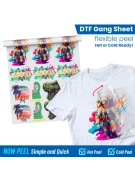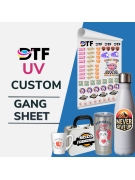A Detailed Comparison: DTF Transfers vs Screen Printing - Which is the Better Choice?

The textile printing industry has evolved significantly, and with it, your options for producing high-quality printed garments have expanded. As someone looking to understand the best methods for printing custom apparel, you may find yourself comparing the innovative Direct to Film (DTF) transfers and the traditional screen printing. In this extensive article, we will dissect these two printing techniques to help you make an informed decision on which is the better choice for your specific needs.
Introduction to DTF Transfers and Screen Printing
Before diving into the depths of comparison, it's essential to have a foundational understanding of both DTF transfers and screen printing. These methods each have unique processes, benefits, and drawbacks, and knowing the basics will provide you with the context needed for a comprehensive evaluation.
What is DTF Transfers?
DTF transfers, which stands for Direct to Film, is a relatively new printing technique that involves printing a design onto a special film and then transferring it onto the fabric. This process begins with creating your design digitally, which is then printed onto a clear PET film using special DTF inks. After printing, an adhesive powder is applied to the ink, and the design is cured using heat to melt the adhesive. The final step is to transfer the design from the film to the garment using heat and pressure.
DTF transfers are celebrated for their versatility, as they can be used on a wide range of fabric types and colors, including dark textiles, without requiring any changes to the design. The process is also less labor-intensive than screen printing, making it accessible for both small and large-scale production.
What is Screen Printing?
Screen printing, also known as silk screening, is a time-honored method that has been used for decades to print designs onto fabric and other substrates. This technique involves creating a stencil (the screen) and using it to apply layers of ink onto the printing surface. Each color in the design requires a separate screen, making the process more complex for designs with multiple colors.
Despite its labor-intensive nature, screen printing is revered for its durability and vibrant colors, particularly for large orders. It’s a popular choice for those looking to produce prints that can withstand the test of time and frequent washing.
Comparison of DTF Transfers and Screen Printing
When comparing DTF transfers and screen printing, several factors come into play, including the quality, durability, cost, and versatility of each method. Understanding these factors will help you discern which method aligns best with your project's requirements.
Advantages of DTF Transfers
One of the most significant advantages of DTF transfers is the ease of setup and flexibility in printing. Unlike screen printing, there is no need for multiple screens, which means you can print designs with numerous colors without additional preparation time and cost. The process is faster and more efficient, especially for small to medium-sized batches or one-off designs.
Another benefit of DTF transfers is the quality of detail that can be achieved. Since designs are digitally printed, even the most intricate details and gradients can be reproduced with precision. This level of detail is particularly beneficial for complex logos or artworks that demand high fidelity.
Furthermore, DTF transfers are highly versatile in terms of the substrates they can adhere to. You can transfer designs to a variety of materials, including cotton, polyester, and blends. This adaptability makes DTF an attractive option for businesses that print on diverse types of apparel.
Disadvantages of DTF Transfers
Despite its many advantages, DTF transfers also present some limitations. One of the primary concerns is the feel of the print on the fabric. The transferred film can sometimes result in a more rigid feel, which may not be desirable for all garments, particularly those intended for comfort wear.
Another potential drawback is the durability of the prints. While DTF transfers can withstand washing and wear, they may not be as resilient as screen-printed designs in the long term. This is an important consideration if you're producing items that require extensive washing or are subject to heavy wear.
Lastly, the initial setup costs for DTF transfers can be higher than other printing methods due to the specialized equipment and inks required. This investment may be a barrier for small businesses or startups with limited budgets.
Advantages of Screen Printing
Screen printing is renowned for its exceptional print quality and durability. The inks used in screen printing are absorbed deeply into the fabric, resulting in vibrant, long-lasting colors that can endure frequent washing without fading. This makes it a preferred method for apparel that needs to maintain its appearance over time.
Moreover, screen printing is cost-effective for large orders since the bulk of the cost is in the setup. Once the screens are created, producing additional prints is relatively inexpensive, making the per-unit cost lower as the quantity increases.
Additionally, the tactile quality of screen-printed designs is often seen as a positive attribute. The slight elevation and texture created by the ink can add a premium feel to the printed garment, enhancing its perceived value.
Disadvantages of Screen Printing
On the flip side, screen printing can be less efficient for small orders or designs with many colors. The necessity for separate screens for each color means more preparation time and higher costs, which can be prohibitive for limited runs or intricate multicolored designs.
The process of screen printing is also more complex and time-consuming, requiring skilled labor and precise alignment, particularly for designs with multiple layers. This complexity can lead to longer turnaround times compared to DTF transfers.
Another limitation of screen printing is its restriction on the types of fabrics that can be printed. While it works well on cotton and some blends, printing on dark fabrics or synthetic materials like polyester can be challenging without additional preparation and equipment.
DTF Transfers vs Screen Printing - Which is best for your needs?
Deciding between DTF transfers and screen printing ultimately depends on the specific needs of your project. Consider the scale of your production, the complexity of your designs, the type of fabric you are printing on, and the importance of print durability in your decision-making process.
If you are looking for flexibility, ease of setup, and the ability to print detailed designs on various materials, DTF transfers may be the way to go. This method is particularly suitable for small to medium-sized orders, one-off prints, or personalized items.
Conversely, if you are producing large quantities of apparel with a limited color palette, screen printing might be more economical and practical. Its durability and cost-effectiveness for large orders make it a staple in the industry for high-volume projects.
Conclusion
Both DTF transfers and screen printing have their rightful place in the garment decoration industry. Your choice between the two should be guided by your project's specific requirements and priorities. Whether you value flexibility, detail, and versatility, or durability, cost-efficiency, and the traditional feel of screen prints will determine the better choice for your needs.
Remember, the printing method you choose will significantly impact the final product's quality, longevity, and appeal. Take the time to weigh the pros and cons, and consider how each method aligns with your business model and customer expectations.
As you navigate your options, don’t hesitate to seek out samples, ask for quotes, and consult with printing professionals. Your informed decision will be the stepping stone to producing exceptional printed garments that resonate with your audience and stand the test of time.
At DTF Transfers Now, we look forward to work with you and help you create those amazing products! Reach out now and start your journey!





Leave a comment